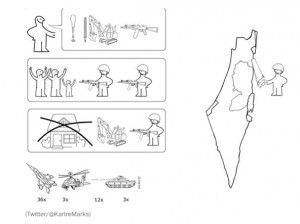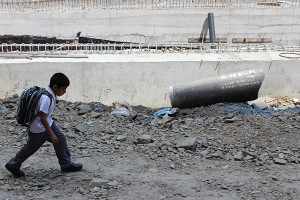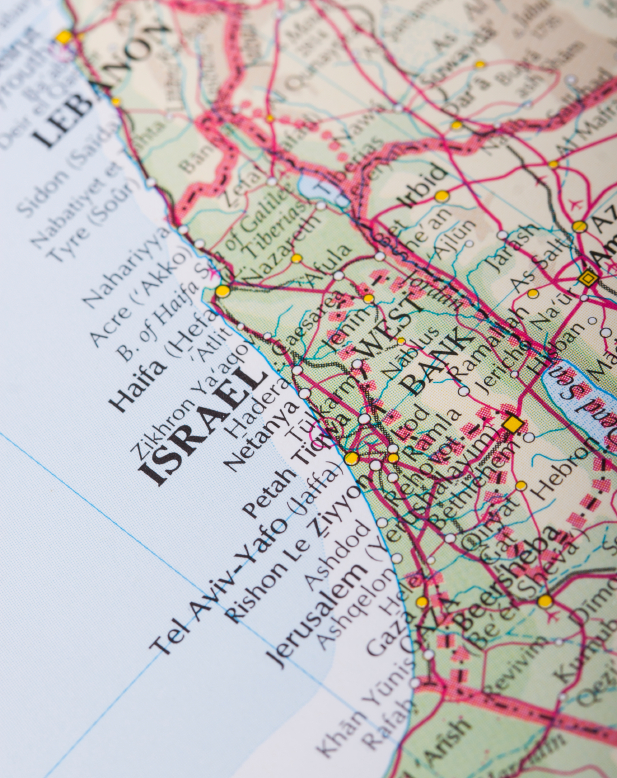Musa was jailed six times in the course of the first and second intifadas - the Palestinian uprisings in the late 1980s and early 2000s. The longest stretch was three years from 1989, but he had been inside various prisons in Israel and the Palestinian territories in the 1990s and 2000s. He had used the useless time to learn Hebrew and a bit of French.
We were in Musa’s pickup truck, speeding along a back route in the West Bank to the checkpoint that marks entry into Israel, from where Tel Aviv airport was only ten minutes away. Four of us - a Briton, a Norwegian, a Latvian and an African-American - were on our way out of Palestine after participating in a critical geographers’ conference in Ramallah: despite the odd mix, we were all ‘respectable’ nationalities, backed by sound paperwork, unlike many of those who actually live in this land.
A wiry forty-something, with edgy, nervous energy, Musa pointed out places in the West Bank landscape by then familiar to us. ‘You see that Palestinian village, just there the settlers took land’; ‘here they put a road for the settlers so now the locals can’t get to their olive trees’; ‘do you notice how the settlements don’t have black water tanks on their roofs like Palestinian houses? That’s because they are allowed to draw water direct from the ground, which Palestinians cannot do’. We approached the first checkpoint, which had been moved further into Palestinian territory so as to claim just a little bit more land for Israel - the creeping, incremental pattern we had learnt about during our stay. Musa made some faux-friendly gesture to the Israeli military woman standing there and she indifferently gestured us through.
Musa has a Jerusalem ID, which allows him to live in that city, but he prefers to live in one of the suburbs that sprawl around Ramallah, and that border Jerusalem but are divided from it by Israel’s separation wall. This is risky because he could be stripped of residence status by either the Palestinian Authority or the Israelis. But it is this liminality that allows him to ply a trade moving people across the many borders and checkpoints that are inscribed on the landscape. His other valuable asset is his Israeli number plates which allow him to cross at this checkpoint, when most Palestinians cannot. Essentially he makes a living from his location in the interstices of interlocking bureaucracies of place.
As easy as ABC

Reproduced with permission from @KarlreMarks
The Oslo accords paved the way for the establishment of a Palestinian quasi-state in the West Bank and Gaza strip, and the establishment of the Palestinian Authority (PA) to administer it in the first half of the 1990s. However the Oslo deal also included a division of territory which has proved the undoing of any idea of a feasible state for the Palestinians. The West Bank and Jerusalem are subject to a three-fold division of territory. ‘Area C’, representing more than 60% of the West Bank, is under direct control of the Israelis - essentially the security forces. Palestinians are prohibited from building or developing this area and are under constant pressure - including demolition of homes and property - to move out. ‘Area B’ accounts for about 22% of the West Bank and is nominally under joint control: the PA does the civil administration, but Israel controls security. The remaining sliver of territory - ‘Area A’, which stands at 18% or less - is under PA control. As if this were not bad enough, even the land which Palestinians do have some say over is split by filigrees of land which is increasingly colonised by Jewish settlers.
Settling scores
At the time of my first visit here, twenty years ago in the mid-1990s, there were some 130,000 settlers in the West Bank and around 157,000 in East Jerusalem. By the time of our visit in 2015 there were some 360,000 settlers in 135 ‘official’ settlements and 100 unofficial ‘outposts’ in the West Bank, and another 200,000 settlers in East Jerusalem. The land-grabbing now is relentless and so too other everyday morale-sapping things that Palestinians have to endure - far worse than 20 years ago. The settlements have expanded enormously, and dominate many of the hilltops. They monopolise the ground water and command other infrastructural resources that are out of reach of Palestinians. It sounds hackneyed, but the resilience of the people in the face of this is remarkable. Pent-up anger seethes underneath nevertheless, and explodes among the youth on what seems a daily basis.
We are there at what seems a volatile time - or maybe this is what it is like all the time. On the evening of our arrival in Jerusalem, before the conference, we watch settlers march past the Old City. It is Tisha B’av, the day that Jews mark the destruction of the Temple in Jerusalem, and when hard-core settlers often reassert their presence. Early next morning we stumble upon a small demonstration of about 30 young Palestinian women against Israeli riot police who are blocking their way (we learn later) to Al Aqsa mosque where some settlers have entered to assert their claims on this religious site. There is a mighty stand-off later with tear gas and people dispersed all over the place.

Lana Al-Shami - the Long Way Home
COMPAS photo competition 2014
Things take a grislier turn later in the week, when settlers lob a petrol bomb into a West Bank Palestinian house that contained the parents and two children. The parents and older child got out - though with 60-80% burns. They could not get the toddler out and he burned to death. The house, near Nablus, was daubed with the slogans ‘revenge’, ‘messiah’ and ‘price-tag’: the first and last refer to a (rare) decision by the courts stopping the settlers from grabbing and building on yet more Palestinian land. The outrage sparked yet more unrest among Palestinian youth in both the West Bank and Gaza. Someone remarks that ‘the settlers are Israel’s Daesh’ (Islamic State).
Checking out
At the airport perimeter checkpoint, Musa nervously explained in Hebrew to the military guards why we had been in the West Bank: attending a conference held in Jerusalem and Ramallah, a story which we echo when asked.
At airport check-in we are quizzed again by a nervous, solemn security guard. They are suspicious of us as a group and of our presence in the West Bank. The different passports are passed to a more senior guy for scrutiny: another man in black polyester suit eyes us over. Eventually we are let through - then there is yet another security scan and one of us is singled out for yet more checks. It is an intimidating experience, but nothing approaching the treatment that Palestinians endure daily in their own land.
Three months on from our visit, the situation in Palestine has deteriorated further to the extent that talk of a third intifada gathers pace. Palestinian youth are taking things into their own hands, outside the grip of the PA and the militant groups. For the first time, young women are taking part in significant numbers. As Yasmin, a 15-year old school girl interviewed by the Observer put it, ‘...more girls are participating. We want to protect our country. We are here for one another and to look after each other. This is the first time for us. Everyone has to help and we are here to help the boys - it’s our duty to participate.’
